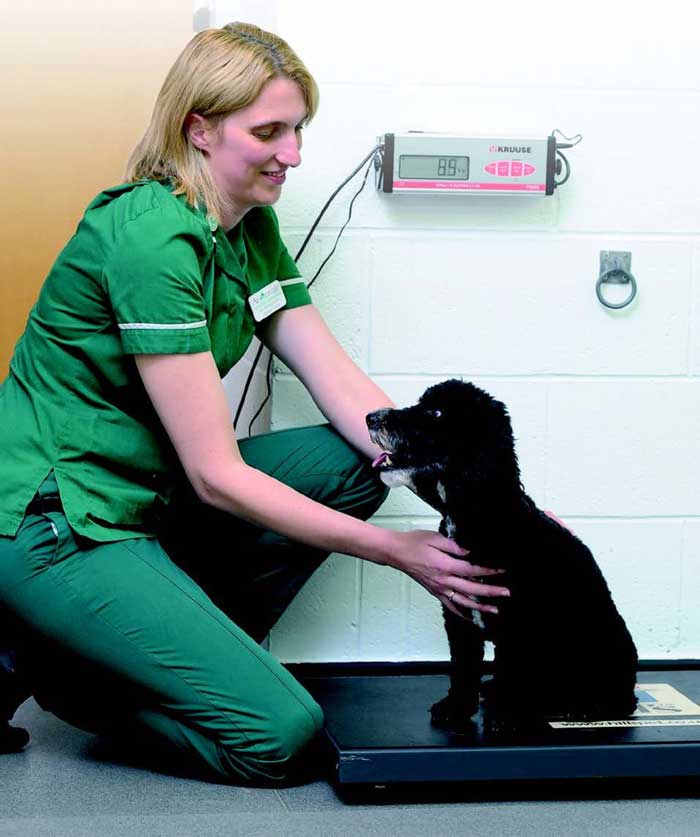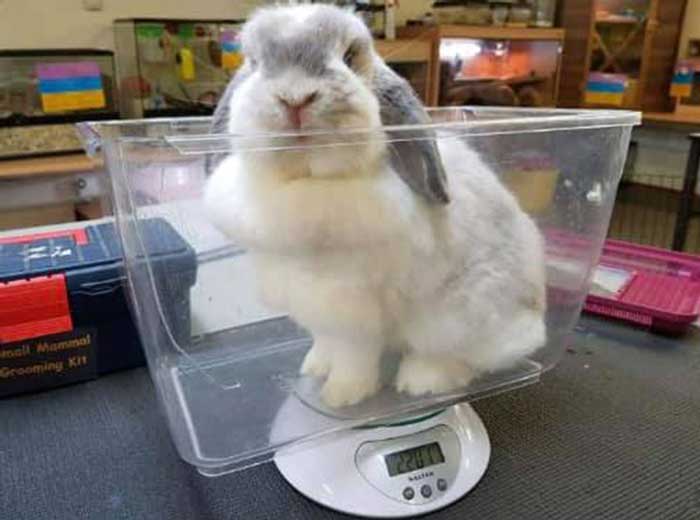9 Jan 2021

Image © YacobchukOlena / Fotolia
VNs have an oath to promote the health and welfare of animals above all. When declaring the oath and signing the register they pledge to a service of promoting animal health (RCVS, 2020). Pet obesity should be considered with the seriousness of the issue. Under the Animal Welfare Act 2006, owners have a duty of care to maintain the health of their pets.
Veterinary nurses have an essential role in helping owners with education, management, and support to achieve and maintain healthy pet weight.
An animal can be classified as obese when its bodyweight exceeds 10% to 20% of its recommended weight (German, 2006). According to the Pet Food Manufacturers’ Association (PFMA; 2019b), 51% of dogs, 44% of cats and 29% of small mammals are considered overweight or obese. This as a population number is significant and explains why obesity clinics are more commonplace in the veterinary environment.
It is important VNs acknowledge their role as figureheads, therefore encouraging healthy weight management and also demonstrating this with their own animals.
The management of overweight pets requires input from the whole team – it also requires staff to invest time and money, but they also need to recognise the seriousness of this disease.
Managing obesity and overweight pets takes the role of the veterinary nurse and nutrition to a different level. Not only do they have to recognise dietary management, but have a clear understanding of the complex human-animal bond and interaction.
A study completed in 2018 found the majority of adults – around 63% – were obese (NHS, 2020). Significance exists in terms of the parallel between owner and pet obesity, so this may explain, to some part, why this sharp increase in recent times in overweight pets has occurred.
One must consider the problem of guilt-treating and guilt-feeding – evidence exists that another link exists between child obesity and pet obesity, with this issue at the heart of the matter (Pretlow and Corbee, 2016).
One the biggest hurdles in veterinary practice is getting the owner to acknowledge his or her pet is overweight and/or obese (Endenburg et al, 2018).
To be able to achieve an effective weight management programme, it is important the owner is engaged and willing to commit to it. Some of the key statistics identify that owners do not recognise their animal is overweight, almost 68% of owners think their pet is exactly the right size and 67% admit they are not concerned about pet obesity (PFMA, 2019b).
It really does start with the communication and careful selection of the appropriate clients. A significant amount of negativity exists around the words obese, fat or chubby (Ward, 2017). So, when trying to approach the owner for the weight programme, careful selection of words should be considered.
The change of approach may benefit to gain trust with clients – an example could include: “Nero is now approaching his later years in life – it is my responsibility to look after his health and he is currently sitting outside what we would recommend as healthy weight.” This could then be followed up with a discussion around body condition scoring (BCS), including a hands-on demonstration of some of the key clinical signs of obesity in pets.
Key signs of obesity in dogs and cats include:
Signs of obesity in rabbits include:
It may be useful to have images of the BCS and various sources of this are available, depending on the use of the five or nine-point BCS. The PFMA also has sizometers for a variety of commonly kept pets.
Once the animal and owner have been identified as a suitable candidate to be part of a weight management programme, it is a good time to start a documented weight management journey.
An effective weight management programme will include most of the following techniques:
The owner must understand the possible health implications of obesity – especially around arthritis and brachycephalic breeds.

As professionals, the VN should be prepared for owners to not understand or appreciate the ideal weight their animal should be. Many VNs have animals of their own, so are able to understand the complex bonds that are between the pet and its family; however, this should also provide the tools to educate the owner efficiently.
Also, it is important as veterinary staff that the owner is not berated for the reasons the animal is becoming overweight. It may be he or she is suffering from a mental health crisis and the animal is his or her comfort, so has excessively treated the animal for being there.
To gain efficient information to formulate the effective weight management plan, asking open-ended questions can prove beneficial. This is best achieved by asking the owner why he or she thinks his or her animal is putting on weight; also ask if he or she understands the consequences of the animal being overweight. It is commonplace to have emotive answers such as: “I feel guilty if I do not give them a treat – especially when they look so sad at the treat drawer.” This information will help build a rapport with the client, but also provide information about the owner’s perspective and any possible challenges that may need to be addressed (Linder, 2014).
The nutritional assessment should be completed with a discussion on what the animal is commonly fed, who does this, does it have access to treats and if so, how many? Also, ask if the animal gets table scraps or is allowed to lick the plates, or about any other relevant food sources. This will give key details as to whether the owner is sticking to any form of diet plan in the home environment. It will also provide information as to the impact other family members may be having on the animal’s diet.
The veterinary practice may consider completing a full physical health assessment, including blood and urine work-ups, to rule out any other problems that may be impacting the animal’s weight. This may not be suitable for all clients and should not be a one-stop plan. Some owners may not have the funds to cover enhanced blood and urine analysis – support should be given to these owners, focusing more on education and observation.
At this point, taking digital photos of the animal may be useful to provide a before and after tracking profile of the animal’s weight loss. It also gives the owner something tangible to see. This can increase adherence to the plan and owner compliance. The VN may choose to use the photo to indicate and educate the owner of the signs of obesity evident in his or her pet. Some owners will like to also see this information tracked on some form of graph – seeing this going down can be extremely positive and motivating.

When considering changing a pet’s diet, the VN must consider the economic status of the client. When educating around diet choice or changes, it is important to know what the client can afford so diet choice can be led to a diet that will be used continually and the main source of nutrition.
Owners will always have personal preference over the choice between wet or dry food for their pet. Within weight management programmes, most specifically prepared diets will be complete diets that do not require any other food sources to meet the nutritional needs (Table 1).
| Table 1. Common diet types for pets | |
|---|---|
| Diet type | Description |
| Complete | Provides all the nutrients and animal’s needs without the need for further supplementation. |
| Complementary | These foods are not nutritionally complete and are designed to be fed as more than one component. An example would be a meat and mixer combination. |
Prescription or dietary-led diets will be lower in calories, therefore reducing the daily caloric intake if owners follow the plans. This is where the next issue comes in – treats.
One of the main issues to address is treat management. Many dog and cat owners will treat their animals because they feel they cannot deny them, or feel guilty if they do. Getting owners to weigh out daily rations may prove beneficial as they can then take the treats out of this ration. Ad-lib feeding can be very difficult to maintain when looking at dietary management. If a client insists on this method, get him or her to weigh the daily amount and store it in an airtight container so he or she can top up the food throughout the day, continuing the current feeding method (Table 2).
| Table 2. Different feeding methods and the impact on weight management |
|
|---|---|
| Feeding technique | Definition |
| Ad lib | This is where the food is continuously topped up. Little control exists for the amount of food that is fed to the animal. Careful management of this method can ensure the animal is not overfed. |
| Time restricted | This is where the food is fed with a time limit. The bowl is placed and lifted within a period. This can be managed to ensure the owners are following feeding amounts on packets. |
| Amount restricted | This is when the food is measured as to the animal’s weight and left for the animal to eat. This can sometimes lend the food to go off and become unpalatable. |
| Time and amount restricted | This is where the food is measured and left for a certain period of time before removing. |
Advise the owner on suitable treats. He or she may not appreciate the calorie value of human-based treats; for example, a small piece of cheese. Education is the best answer to this. It is beneficial to have educational posters and leaflets that can be given to the client as part of the weight management plan, and a carefully displayed noticeboard should not be overlooked.
When advising a client to change diets it should be completed over a 7 to 14-day period (PDSA, 2020).
Again, careful consideration should be made before recommending diet choices; cost and pre-existing conditions may influence diet options.
Careful consideration must be completed before recommending changes to an animal’s exercise regime. Not only should the weight of the animal be considered, but any pre-existing conditions and age. If evidence of arthritic changes is present, this will result in very careful consideration. The breed type will also need to be observed; brachycephalic breeds may struggle with increased exercise.
Some suggestions could include hydrotherapy, slowly increasing exercise, playing and scent games. Movement impact should be monitored as this could cause further injuries and stress to joints.
It should be noted the utmost importance for weight management is that the owners are educated on diets, weight control and the long-term needs for maintaining a healthy animal weight. Without owner compliance the prospect for success is seriously low.
To summarise, the role of the VN is paramount in dealing with this serious issue of pet obesity. As figureheads for animal welfare, it is important VNs have the support and respect from the practice to manage this complex issue.
Victoria Bowes
Job Title